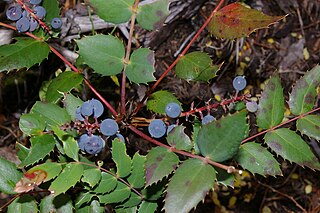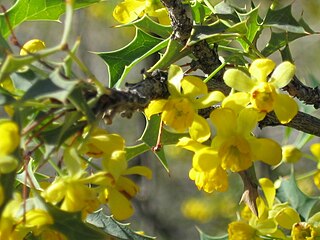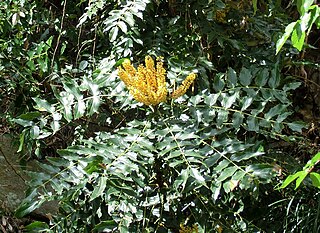
Forsythia, is a genus of flowering plants in the olive family Oleaceae. There are about 11 species, mostly native to eastern Asia, but one native to southeastern Europe. Forsythia – also one of the plant's common names – is named after the botanist William Forsyth.

Berberis aquifolium, the Oregon grape or holly-leaved barberry, is a species of flowering plant in the family Berberidaceae, native to western North America. It is an evergreen shrub growing 1–3 meters tall and 1.5 m (5 ft) wide, with pinnate leaves consisting of spiny leaflets, and dense clusters of yellow flowers in early spring, followed by dark bluish-black berries.

Mahonia is a formerly accepted genus of approximately 70 species of shrubs or, rarely, small trees with evergreen leaves in the family Berberidaceae, native to eastern Asia, the Himalaya, North America, and Central America. They are closely related to the genus Berberis and as of 2023 the majority of botanical sources list it as a synonym for Berberis.

Berberis, commonly known as barberry, is a large genus of deciduous and evergreen shrubs from 1–5 m (3.3–16.4 ft) tall, found throughout temperate and subtropical regions of the world. Species diversity is greatest in South America and Asia; Europe, Africa and North America have native species as well. The best-known Berberis species is the European barberry, Berberis vulgaris, which is common in Europe, North Africa, the Middle East, and central Asia, and has been widely introduced in North America. Many of the species have spines on the shoots and all along the margins of the leaves.

Euonymus japonicus is a species of flowering plant in the family Celastraceae, native to Japan, Korea and China. It is an evergreen shrub or small tree growing to 2–8 m tall, with opposite, oval leaves 3–7 cm long with finely serrated margins. The flowers are inconspicuous, greenish-white, 5 mm diameter. In autumn, orange fruit hangs below the flaring pink seed coverings.

Berberis nervosa, commonly known as dwarf Oregon-grape, Cascade barberry, Cascade Oregon-grape, or dull Oregon-grape, is a flowering plant native to the northwest coast of North America from southern British Columbia south to central California, with an isolated population inland in northern Idaho. It is especially common in second growth, Douglas-fir or western redcedar forests, making use of those pools of sunlight that intermittently reach the ground.

Berberis repens commonly known as creeping mahonia, creeping grape holly, or creeping barberry, is a species of Berberis native to most of the western United States and two western provinces of Canada. It is low growing shrub that spreads by underground stems. As a species it is well adapted to fire and is a very common understory plant in western forests. An evergreen species, it provides food to deer and elk in winter and can make up a significant part of their diet. The berries are eaten by birds and small mammals, aiding it in spreading to recently disturbed areas. It has found use as a xeric ornamental plant and has escaped from cultivation in areas beyond its native range.

Berberis oiwakensis is a species of plant in the barberry family, Berberidaceae. It is native to Taiwan, China and Myanmar, where it occurs at elevations of 600 to 3800 m. It has recently been found naturalized in South Africa.

Berberis nevinii, known by the common name Nevin's barberry, is a species of flowering shrub in the barberry family.
Berberis × hortensis is an interspecific hybrid shrub. Its parents are Berberis oiwakensis and Berberis japonica. It was raised in gardens during the 20th century, and has become an important garden and landscape plant.

Berberis fortunei is a species of shrub in the family Berberidaceae, the barberry family, described in 1846. It is endemic to China, found in the provinces of Chongqing, Guangxi, Guizhou, Hubei, Hunan, Jiangxi, Sichuan, Taiwan, and Zhejiang. It is grown as an ornamental in many lands, with common names including Chinese mahonia, Fortune's mahonia, and holly grape.

Berberis harrisoniana is a rare species of flowering plant in the barberry family, Berberidaceae. It is known by the common names Kofa barberry, Kofa Mountain barberry, Harrison's barberry, and red barberry.

Berberis haematocarpa, Woot. with the common names red barberry, red Mexican barbery, Colorado barberry and Mexican barberry, is a species in the Barberry family in southwestern North America. It is also sometimes called algerita, but that name is more often applied to its relative, Mahonia trifoliolata.

Berberis bealei, also known as leatherleaf mahonia, Beale's barberry, is a species of evergreen shrub native to mainland China. The species has been regarded as the same species as Berberis japonica, native to Taiwan, but the two differ consistently in certain floral and leaf characters. Both species are widely cultivated in many countries as ornamentals. Berberis bealei has reportedly escaped cultivation and become established in the wild in scattered places in the south-eastern United States from Arkansas to Florida to Delaware.

Berberis gracilis is a plant species native to the Mexico, widely distributed from Tamaulipas to Oaxaca.
Berberis hancockiana is a species of flowering plant in the family Berberidaceae, first described in 1917. It is endemic to Yunnan Province in southwestern China.
Berberis longibracteata is a shrub in the family Berberidaceae, first described as a species in 1917. It is endemic to China, found in Sichuan and Yunnan Provinces.
Berberis monyulensis is a shrub in the family Berberidaceae first described as a species in 1961. It is endemic to Tibet.

Berberis napaulensis Nepali: जमाने मान्द्रो is a shrub in the family Berberidaceae described as a species in 1821. It is native to China and the Himalayas. This species is used medicinally throughout the Sikkim Eastern Himalayas.
Berberis setosa is a shrub in the Berberidaceae described as a species in 1908. It is endemic to China, known from the provinces of Sichuan and Yunnan.















